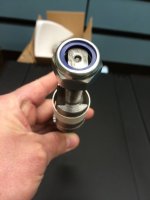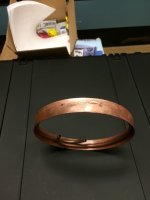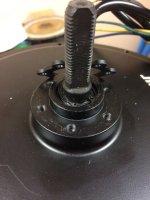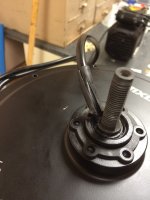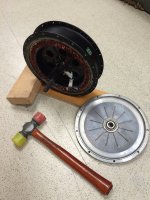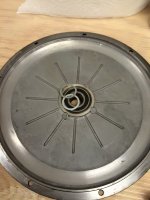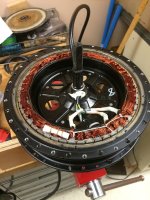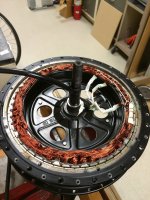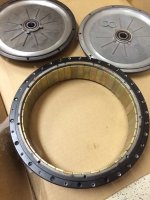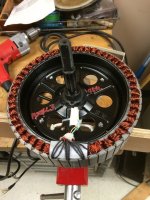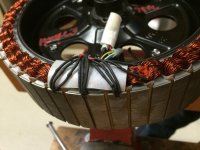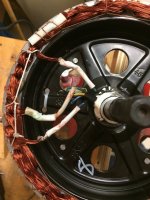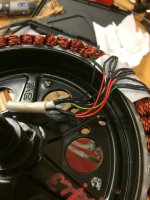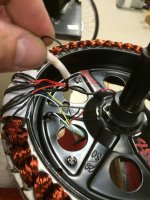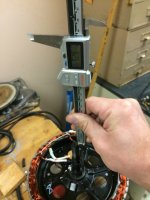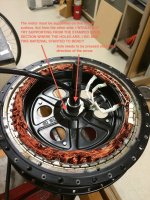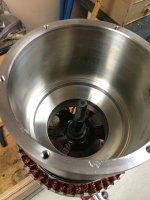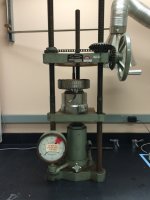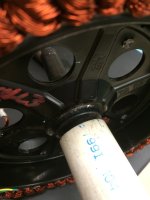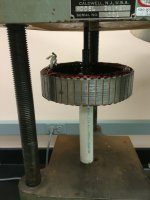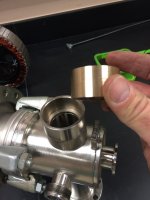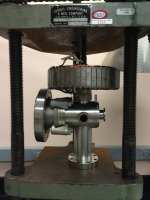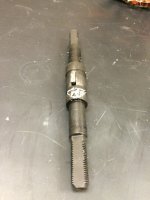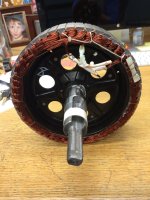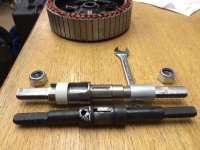edventure
100 W
I am in the process of installing an upgraded axle and copper cooling loops that were purchased from user Linukas. This kit is for a VS1 MXUS 3000 motor and will not work in the newer VS2 motor, but you may want to track what Linukas is up to, because he has talked about possibly creating a kit for the VS2 in the future. I posted an earlier thread under MXUS 3000 Hub Motor, but decided to start a new one here and have copied some of that information here. I was able to remove the original axle this evening and will post how I did this with some photos a bit later. Here is a link to the original thread where Linukas explained some of his mods. http://endless-sphere.com/forums/viewtopic.php?f=2&t=63142&hilit=Linukas&start=225
Ordered an upgraded axle from Linukas that has dual slots, one for heavier gauge wires and the other for the liquid cooling lines. He said this was a lower quality milling than another option he has, but he indicated he has used it on numerous bikes with no problems. It looks much better than the standard axle to me. I still need to have the side cover milled on one side to except the new larger 42mm OD x 30mm ID bearing. I have ordered and received new 12 gauge phase wires, from Turnigy that have a silicone jacket that is rated to 200C. Easily could have fit 10awg wire, but I did not see the reason based on the currents I will be running. Additionally I wanted the wires to have plenty of space to make assembling the motor easy. These are basically the same wires that come from the Lyen controller, so a good match and I was able to get the Blue, Yellow and Green to match the controller.
I also ordered the cooling lines TIG welded to the thin copper plate that will draw the heat away from the motor. The photos only show one loop, but Linukas actually sent two of these. I plan on placing Swagelok fittings with a barbed adapter to connect the actual soft lines to cut down on the possibility of leaking. I think the parts from Linukas were well worth what I paid for them. Placed some photos below if you're interested. Will update as things come together hopefully before January is out. Also, plan on taking the dimensions of the axle and drawing up a CAD file in Sketchup so I can share it here. Linukas had said he was ok with this in an earlier post. I want to thank Linukas for working with me on this and his willingness to answer my questions and get the parts to me. The water pump I plan on using will use minimal power and theoretically should not need to be turned on often, mainly when I am climbing hills that are 3 miles long where heat buildup becomes an issue. This should be very effective for removing heat from the motor in a short period of time. Once I get it working we will see.
Ed
Ordered an upgraded axle from Linukas that has dual slots, one for heavier gauge wires and the other for the liquid cooling lines. He said this was a lower quality milling than another option he has, but he indicated he has used it on numerous bikes with no problems. It looks much better than the standard axle to me. I still need to have the side cover milled on one side to except the new larger 42mm OD x 30mm ID bearing. I have ordered and received new 12 gauge phase wires, from Turnigy that have a silicone jacket that is rated to 200C. Easily could have fit 10awg wire, but I did not see the reason based on the currents I will be running. Additionally I wanted the wires to have plenty of space to make assembling the motor easy. These are basically the same wires that come from the Lyen controller, so a good match and I was able to get the Blue, Yellow and Green to match the controller.
I also ordered the cooling lines TIG welded to the thin copper plate that will draw the heat away from the motor. The photos only show one loop, but Linukas actually sent two of these. I plan on placing Swagelok fittings with a barbed adapter to connect the actual soft lines to cut down on the possibility of leaking. I think the parts from Linukas were well worth what I paid for them. Placed some photos below if you're interested. Will update as things come together hopefully before January is out. Also, plan on taking the dimensions of the axle and drawing up a CAD file in Sketchup so I can share it here. Linukas had said he was ok with this in an earlier post. I want to thank Linukas for working with me on this and his willingness to answer my questions and get the parts to me. The water pump I plan on using will use minimal power and theoretically should not need to be turned on often, mainly when I am climbing hills that are 3 miles long where heat buildup becomes an issue. This should be very effective for removing heat from the motor in a short period of time. Once I get it working we will see.
Ed




